
Paid-in capital is the actual investment by the stockholders; retained earnings is the investment by the stockholders through earnings not yet withdrawn. The statement of retained earnings is a financial statement that is prepared to reconcile the beginning and ending retained earnings balances. Retained earnings are the profits or net income that a company chooses to keep rather than distribute it to the shareholders. Retained earnings refer to the portion of a company’s profits that are reinvested back into the business, rather than being distributed to shareholders. Over time, retained earnings can have a significant impact on a company’s growth and profitability.
What is a statement of retained earnings?
- Increasing Retained Earnings suggest that a company is saving more of its profits for future growth or to strengthen its financial position.
- Retained earnings is the cumulative amount of earnings since the corporation was formed minus the cumulative amount of dividends that were declared.
- Accounting terms can cause considerable confusion, and knowing the difference when keeping track of your finances is crucial for accuracy and financial literacy.
- Companies will also usually issue a percentage of all their stock as a dividend (i.e. a 5% stock dividend means you’re giving away 5% of the company’s equity).
Your Bench account’s Overview page offers an at-a-glance summary of your income statement and balance sheet, allowing you to review your profitability and stay on top of your cash flow from month to month. Spend less time figuring out your cash flow and more time optimizing it with Bench. Also, keep in mind that the equation you use to get shareholders’ equity is the same you use to get your working capital. It’s a measure of the resources your small business has at its disposal to fund day-to-day operations. A statement of retained earnings is a formal statement showing the items causing changes in unappropriated and appropriated retained earnings during a stated period of time.
Retained Earnings Formula
You don’t have to work for a giant corporation to know and understand your business’s retained earnings. This calculation will give you the data to know what portion of your profits can be set aside to be reinvested in your business.Retained earnings are also much more than just a number. They’re like a link between your income statement (aka your profile and loss statement) and your balance sheet.

Formula For Retained Earnings

Accountants use the formula to create financial statements, and each transaction must keep the formula in balance. This bookkeeping concept helps accountants post accurate journal entries, so keep it in mind as you learn how to calculate retained earnings. That said, retained earnings can be used to purchase assets such as equipment and inventory. Accordingly, companies with high retained earnings are in a strong position to offer increased dividend payments to shareholders and buy new assets.
Let’s say your company’s dividend policy is to pay 50 percent of its net income out to its investors. In this example, $7,500 would be paid out as dividends and subtracted what is the normal balance for retained earnings from the current total. Next, look at your income statement (also known as the profit and loss statement) for the current period to find your net income (or loss).
- This document is essential as you learn how to calculate retained earnings and other equities.
- For instance, if you prepare a yearly balance sheet, the current year’s opening balance of retained earnings would be the previous year’s closing balance of the retained earnings account.
- Revenue, net profit, and retained earnings are terms frequently used on a company’s balance sheet, but it’s important to understand their differences.
- The schedule uses a corkscrew-type calculation, where the current period opening balance is equal to the prior period closing balance.
- Shareholders, analysts and potential investors use the statement to assess a company’s profitability and dividend payout potential.
- Cash dividends are a cash outflow from the company, reducing its cash balance.

However, the amount of the retained earnings balance could be relatively low even for a financially healthy company, since dividends are paid out from this account. Consequently, the amount of the credit balance does not necessarily indicate the relative success of a business. Retained Earnings are listed on a balance sheet under the shareholder’s equity section at the end of each accounting period. To calculate Retained Earnings, the beginning Retained Earnings balance is added to the net income or loss and then dividend payouts are subtracted. Instead, they reallocate a portion of the RE to common stock and additional paid-in capital accounts. This allocation does not impact the overall size of the company’s balance sheet, but it does decrease the value of stocks per share.

A company’s retained earnings refer to the amount of net income (or loss) accumulated since the beginning of operations minus all dividends distributed to shareholders. Undistributed earnings are retained for reinvestment back into the business, such as for inventory and fixed asset purchases or paying off liabilities. A negative balance in the retained earnings account is called an accumulated https://www.bookstime.com/ deficit. Dividends paid are the cash and stock dividends paid to the stockholders of your company during an accounting period. Where cash dividends are paid out in cash on a per-share basis, stock dividends are dividends given in the form of additional shares as fractions per existing shares. Both cash dividends and stock dividends result in a decrease in retained earnings.
The figure is calculated at the end of each accounting period (monthly/quarterly/annually). As the formula suggests, retained earnings are dependent on the corresponding figure of the previous term. The resultant number may be either positive or negative, depending upon the net income or loss generated by the company over time. Alternatively, the company paying large dividends that exceed the other figures can also lead to the retained earnings going negative.


Leave a Reply